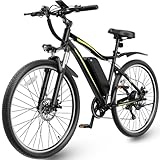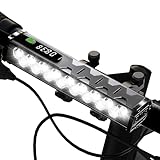If you are in search of the best on/off road mountain bikes, then you’ve come to the right place. Deciding on a bike that can handle both terrains equally well can be a daunting task, as there are so many options available in the market. That’s why we have compiled a list of the top 10 best on/off road mountain bikes for you to consider, along with a comprehensive buying guide to help make your decision easier. In this article, we’ll take a detailed look at each bike so that you can choose the one that best suits your needs. So, let’s dive in and explore!
Get ready for our reviews on the best on/off road mountain bikes, but first, here are some related Amazon products to check out:
Last update on 2025-10-24 at 14:19 / Paid links / Images from Amazon Product Advertising API
Best On/Off Road Mountain Bikes
On/Off Road Mountain Bikes: A Beginner’s Overview
On/Off road mountain bikes, also known as dual sport or adventure bikes, are designed to handle a variety of terrains, including pavement, dirt roads, gravel, and light off-road trails. They typically have wider tires and a more upright riding position than traditional road bikes, but are lighter and more efficient than traditional mountain bikes. On/off road mountain bikes are ideal for riders who want a versatile bike that can handle both paved and unpaved surfaces.
On/off road mountain bikes come in a variety of styles and price points, from entry-level bikes with basic components to high-end models with top-of-the-line features. Some popular brands of on/off road mountain bikes include Trek, Giant, Cannondale, and Specialized. These bikes are perfect for riders who want to explore a range of terrains and enjoy new experiences, whether it’s exploring off-road trails or embarking on a long-distance tour. With their versatility and durability, on/off road mountain bikes are an excellent choice for anyone who wants a bike that can handle anything.
Why is it Important to Consider Buying On/Off Road Mountain Bikes?
Are you in the market for a versatile and durable bike that can handle both on and off-road adventures? An On/Off Road Mountain Bike may be just what you’re looking for. Here are a few key reasons why this style of bike could be a great investment for your cycling needs.
Versatility
On/Off Road Mountain Bikes are an ideal choice for riders who want to explore different terrains and surfaces. They are designed to handle off-road trails, gravel roads, rocky paths, and even city streets. With wider tires, suspension systems, and durable frames, these bikes offer excellent stability, comfort, and control in any condition.
One of the main advantages of On/Off Road Mountain Bikes is their versatility. They can be used for commuting, fitness, recreation, adventure, or competition. Riders can switch between different surfaces and environments without worrying about the performance of their bikes. Moreover, these bikes come with various features and accessories that can help riders customize them to their needs and preferences. Overall, On/Off Road Mountain Bikes are suitable for anyone who wants a reliable, adaptable, and adventurous bike.
Durability
On/Off Road Mountain Bikes are designed to withstand the rigors of off-road riding and provide a durable option for those who regularly ride in challenging conditions. These bikes are typically built with sturdy frames made of materials like aluminum or carbon fiber, which can endure the jolts and bumps of rough terrain.
Additionally, On/Off Road Mountain Bikes are equipped with wide knobby tires that provide excellent grip and stability on a variety of surfaces. They also have powerful brakes that enable riders to stop quickly and avoid accidents. Overall, the durability of these bikes makes them an attractive option for enthusiasts who love to explore the great outdoors on two wheels.
Maneuverability
On/Off Road Mountain Bikes are designed to provide riders with better maneuverability than regular bikes. This is because they have wider tires, a stronger frame, and a suspension system that allows for more shock absorption. With these features, riders can navigate through rough terrain, steep hills and sharp turns with ease.
Furthermore, On/Off Road Mountain Bikes are perfect for riders who need to navigate on both paved and unpaved roads. The tires can manage well on both surfaces and the added suspension system ensures a smoother ride, especially on bumpy terrain. This enhanced maneuverability gives riders confidence and control over their bike, making them ideal for adventurous riders who want to explore different terrains.
Accessibility to different terrains
On/Off road mountain bikes are designed to handle different terrains that traditional road bikes cannot. They are built with wider tires and stronger frames to withstand the rigors of off-road cycling. With an on/off road mountain bike, you have access to a wide variety of terrains, including gravel paths, rocky descents, steep climbs, and muddy trails.
These bikes provide a versatile and efficient option for those who want to explore different terrain, from city streets to backcountry paths. You can ride your on/off road mountain bike through wooded trails, over rocky terrain, across streams, or up steep hills. This type of bike offers the flexibility to enjoy a range of activities, from leisurely rides to more intense mountain biking adventures. With an on/off road mountain bike, you can enjoy the outdoors and explore nature in a way that traditional road bikes cannot match.
Guide to Choose the Best On/Off Road Mountain Bikes
To make the most out of your outdoor adventures, it’s important to have a reliable mountain bike that can handle the demands of on and off-road terrains. However, with so many different types and models available, it can be overwhelming to decide which one is the right fit for you. To simplify this decision-making process, here are some important factors to keep in mind when looking for the best on/off road mountain bikes.
Wheel size
The wheel size of on/off road mountain bikes plays a critical role in determining the type of riding experience you will have. Bigger wheels generally allow for a smoother and faster ride on rough terrains, while smaller wheels offer better maneuverability and control in technical sections. The most common wheel sizes for on/off road mountain bikes are 26 inches, 27.5 inches, and 29 inches. Choosing the right wheel size depends on the type of terrain you will be riding on and your personal preference for speed, control, and maneuverability. So, it is important to consider wheel size before buying an on/off road mountain bike to ensure that you get the best riding experience possible.
In addition, wheel size affects the overall geometry of the bike, including the height and angle of the handlebars, seat post, and pedals. This geometry determines the rider’s position on the bike, which affects their comfort, stability, and power output. Therefore, it is essential to choose a wheel size that matches your body type and riding style, so that you can ride comfortably and efficiently. By taking the time to consider wheel size before buying an on/off road mountain bike, you can ensure that you get a bike that fits you perfectly and delivers the performance you desire.
Suspension
When considering buying an on/off-road mountain bike, it’s essential to consider what type of suspension best suits your needs. Suspension systems are essential components that help absorb the impact of bumps and rough terrain, ensuring a smoother and more comfortable ride. Therefore, it’s crucial to select the right suspension system before making a purchase.
A full suspension bike, for example, offers better overall comfort and handling and can handle more challenging terrains. On the other hand, hardtail bikes are lightweight, provide better control, and are more affordable compared to their full-suspension counterparts. Assessing your needs and matching them to the right suspension system ensures you get the most out of your bike, making it a worthwhile investment in the long run.
Frame material
The frame material is an important factor to consider when buying on/off-road mountain bikes because it affects the durability and performance of the bike. Different materials have different strengths and weaknesses, and choosing the right one for your needs and riding style can greatly enhance your overall biking experience.
For example, aluminum frames are lightweight and stiff, making them ideal for cross-country riding, while carbon fiber frames are known for their strength and shock absorption, making them ideal for downhill and trail riding. Steel frames are known for their durability and flexibility, making them a good choice for recreational and touring riders who want a comfortable ride. By carefully considering the frame material, you can ensure that your bike is optimized for your specific needs and can provide many years of enjoyable riding.
Gearing system
Gearing systems play an important role in the performance of on/off road mountain bikes. It affects factors such as speed, power, and control on different terrains. Mountain bikes with multiple gears offer the rider more options to select the appropriate gear according to the slope, terrain, and rider’s skill level. This results in better climbing up steep hills, faster speeds on flat surfaces and easier control while going downhill. Therefore, it is important to consider the gearing system of a mountain bike before buying one to ensure it suits the rider’s preferred riding style and terrain to maximize their performance and overall riding experience.
Moreover, a good gearing system can improve the durability and longevity of the bike. By shifting to lower gears while climbing or in challenging terrains, the rider reduces the stress on the bike’s chain, derailleur, and cassette and prevents unnecessary wear and tear. As a result, maintenance costs are reduced, and the bike can last longer. In addition, a well-functioning gearing system ensures the rider is not overworking themselves, reducing the likelihood of injury. Overall, when considering purchasing a mountain bike, it is essential to consider the gearing system to ensure a safe, comfortable, and efficient ride.
Brake type
Choosing the right brake type for an on/off road mountain bike is crucial because it affects the bike’s performance and safety. Caliper brakes are lightweight and efficient for smooth roads but lack stopping power on rough terrain. Disc brakes use a rotor and caliper for better stopping power and are ideal for the unpredictable conditions of off-road terrain. They also perform well in wet or muddy conditions. When considering a mountain bike for off-road use, disc brakes are highly recommended for safety reasons.
In conclusion, the brake type is a fundamental factor to consider when purchasing an on/off-road mountain bike. It affects the way you ride and how safe your bike is. Disc brakes are the best option for off-road terrain because they provide better stopping power, have more adjustability, and offer better performance in wet or muddy conditions. It’s important to take the time and invest in a bike with the right brake type to ensure you have a comfortable, safe, and enjoyable ride.
Price range
When it comes to purchasing an on/off-road mountain bike, price range is an important factor to consider because it can significantly impact the quality and performance of the bike. A higher price range generally means higher quality components such as suspension, gears, and brakes. These components are essential for a comfortable and safe ride, especially when cycling on rough terrain.
Additionally, a higher price range often means better durability and longevity of the bike. A cheaper bike may save money upfront, but it may not last as long and will require more frequent repairs and maintenance. In the long run, it may end up being a more expensive option than investing in a higher-priced bike initially. Overall, it’s important to consider price range when purchasing an on/off-road mountain bike to ensure the bike meets your needs and will last for years to come.
FAQs
What is the difference between an on-road and off-road mountain bike?
On-road mountain bikes are designed for riding on paved roads and smoother surfaces such as city streets, bike paths, or smooth dirt roads. They have narrow tires that are smooth and offer less rolling resistance. Their frames are usually lightweight and stiff, which allows them to be more aerodynamic and responsive on flat roads. On-road bikes are not suitable for rough terrains, mountain trails, or off-road terrains.
Off-road mountain bikes, on the other hand, are designed for use on rough terrain. They have wider, more aggressive tires that provide better traction and grip in muddy or rocky terrains. They typically feature a suspension system that absorbs shocks, bounces, and vibrations, making them more comfortable and safe to ride at higher speeds. Off-road bikes are heavier, more durable, and have a sturdy frame, which makes them capable of overcoming tough terrains. However, they are not optimized for speed or agility on smooth roads.
Can an on-road mountain bike handle off-road terrains?
Yes, an on-road mountain bike can handle off-road terrains to a certain extent. On-road mountain bikes are designed to handle rough and uneven terrains to some extent, but they may not be able to perform as well as a dedicated off-road mountain bike.
On-road mountain bikes may have skinnier tires and may not have as much suspension as an off-road mountain bike. This can result in less traction and stability on rough and uneven off-road terrains. However, this can also depend on the specific on-road mountain bike and the terrain being ridden on. In general, an on-road mountain bike can handle light off-road terrains, but for more extreme off-road adventures, it is recommended to use a dedicated off-road mountain bike that is designed for such terrains.
What type of tires should I choose for an on/off road mountain bike?
Carbon fiber handlebars are often preferred by advanced trail mountain bikers because they are lighter in weight, more shock absorbent, and provide better vibration dampening. They are also more comfortable to grip, which can lead to less hand fatigue and more control on the trail. Carbon fiber also allows for more varied shapes and designs, which can offer better ergonomics and a more personalized fit.
However, aluminum handlebars are still a popular choice for many mountain bikers due to their durability, stiffness, and affordability. They are less susceptible to damage from crashes or impacts than carbon fiber, and can also be found in a variety of shapes and sizes to fit a specific rider’s needs. Ultimately, the choice between aluminum and carbon fiber handlebars will depend on a rider’s personal preferences and needs.
Yes, you can adjust the angle and height of your trail mountain bike handlebars to best suit your riding style and comfort level. Most handlebars come with adjustable stem lengths to increase or reduce the height of the bars, while the handlebar tilt can be adjusted by rotating the stem and handlebars. It is important to find the right position that allows you to maintain control, reduce fatigue, and increase performance.
Key Takeaways
After thorough research and analysis, these Top 10 Best On/Off Road Mountain Bikes are definitely worth considering for any avid rider. Each bike offers its own unique features and advantages, depending on the rider’s needs and preferences. Whether it’s for daily commuting, adventurous off-road trips, or competitive racing, these bikes provide excellent performance and durability.
If you’re looking for the best on/off road mountain bike, this list is a great starting point for your search. With a variety of options ranging from budget-friendly to high-end models, there is a bike for every rider. So, pick your favorite, hit the trails, and enjoy the ride!




